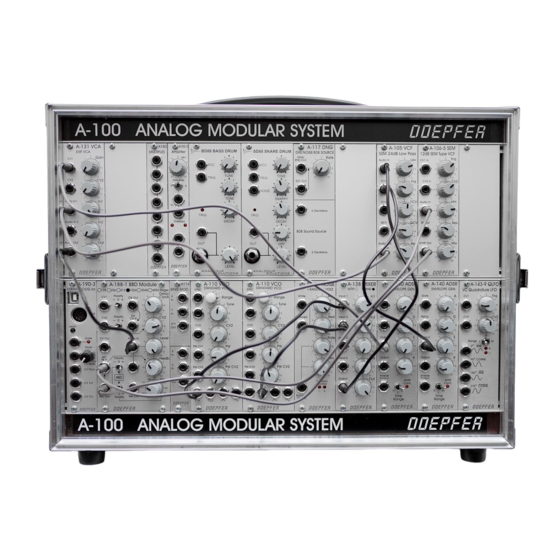DOEPFER
DOEPFER
DOEPFER
DOEPFER
Fig. 3 shows the internal circuit details of the module: the
upper part is the high speed VCO (HSVCO), the lower part
the actual BBD section.
The HSVCO generates the clock signal that is required to
drive the BBD. It has available a manual control and two CV
inputs. CV1 is without attenuator and follows approximately
the 1V/octave standard (for precision 1V/octave applications
an external precision HSVCO is required). CV2 is equipped
with a polarizer.
Polarizer function: In the center position of the polarizer
control the effect of the control voltage applied to the socket
CV2 is zero. Turning the knob clockwise from the center
position the control voltage effect becomes positive with
increasing amount. Turning the knob counterclockwise from
the center position the control voltage effect becomes
negative with increasing amount.
The HSVCO has a CV output available that corresponds to
the sum of all CVs that define the HSVCO's frequency, i.e.
the manual control, CV1 and CV2. It's main purpose is to
control the CV input of external low pass filter(s) that can be
used as anti-aliasing filter and clock filter. If desired a low
pass filter can be used behind the audio output(s) to
suppress the clock noise when the clock frequency falls
below ~15 kHz. Another filter can be used at the audio input
to reduce the max. frequency of the incoming audio signal,
consequently reducing aliasing artefacts. As the CV output
reflects the clock frequency (affected by the manual control,
CV1 and CV2) the external filters automatically follow the
System A-100
clock frequency of the BBD module. The higher the slope of
the external filter (e.g. 12/24/48 dB/octave) the better is the
clock suppression. The HSVCO features also a clock output
that can be used e.g. to synchronize two A-188-2 or an A-
188-2 and A-188-1 (i.e. both BBD modules use the same
clock source) or as high speed clock for other applications
(e.g. graphic VCO, switched capacitor filter).
The clock output of the HSVCO is normalled to the clock
input of the BBD section. The clock input makes it possible
to control the BBD by an external clock source (e.g. another
A-188-2 or A-188-1 or any other clock signal in the required
frequency range). For all clock signals from and to the A-
188-1/2 only short patch cables should be used, as long
cables function as low pass filters for signals above 20kHz.
A two-phase converter generates the two opposite clock
signals that are required to drive the BBD circuits.
The audio input of the BBD module is equipped with an
attenuator that enables to reduce the input level to avoid
distortion. The audio input signal behind the attenuator is
mixed with the feedback signal (details below) and fed to the
audio input of the BBD circuit.
Each tap of the BBD circuit is available as a single output:
396, 662, 1194, 1726, 2790 and 3328. These outputs can
be used for example in an additional external (e.g. voltage
controlled) mixer or for multi-channel applications (e.g. 5.1).
BBD Module A-188-2
5

